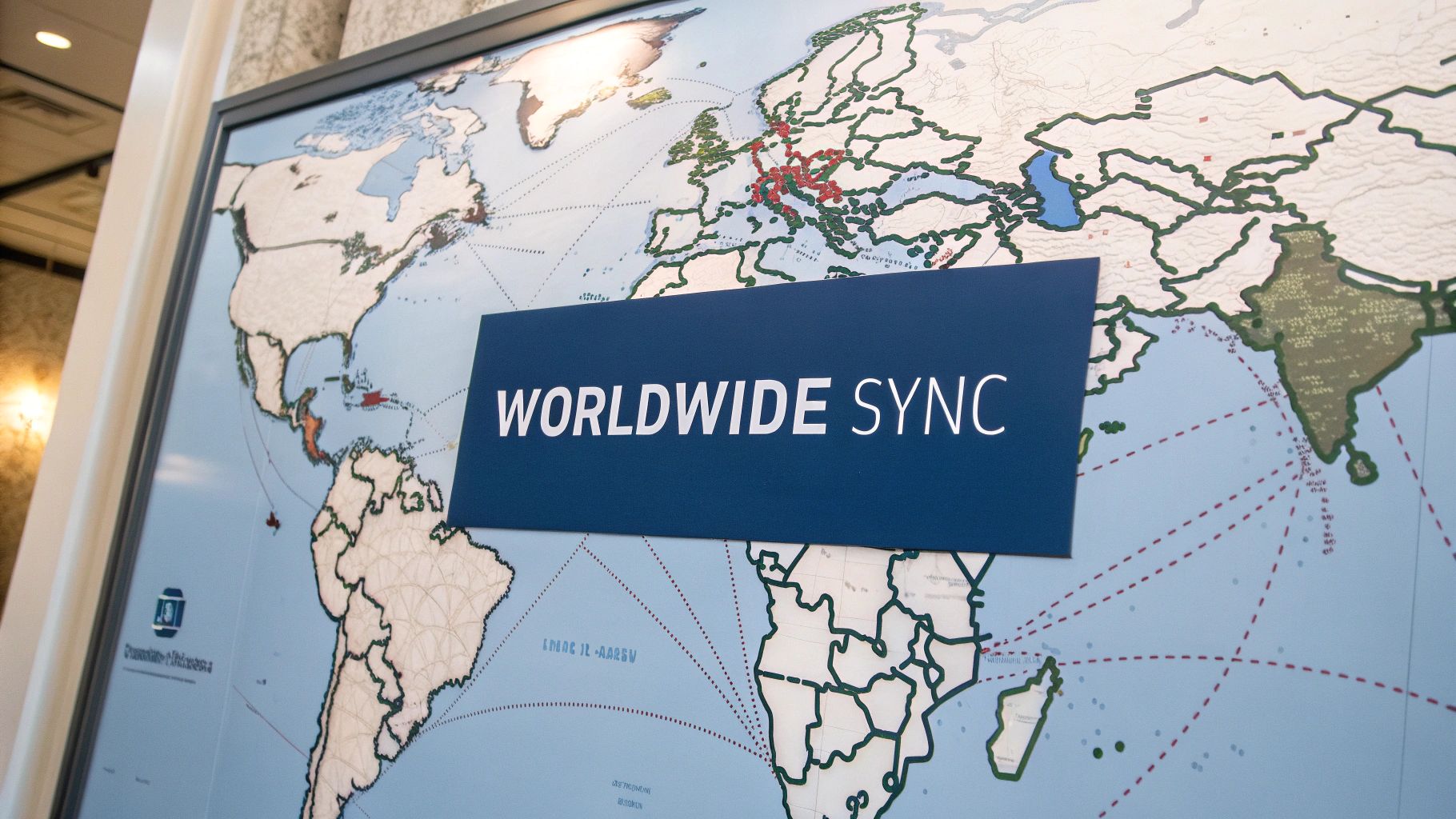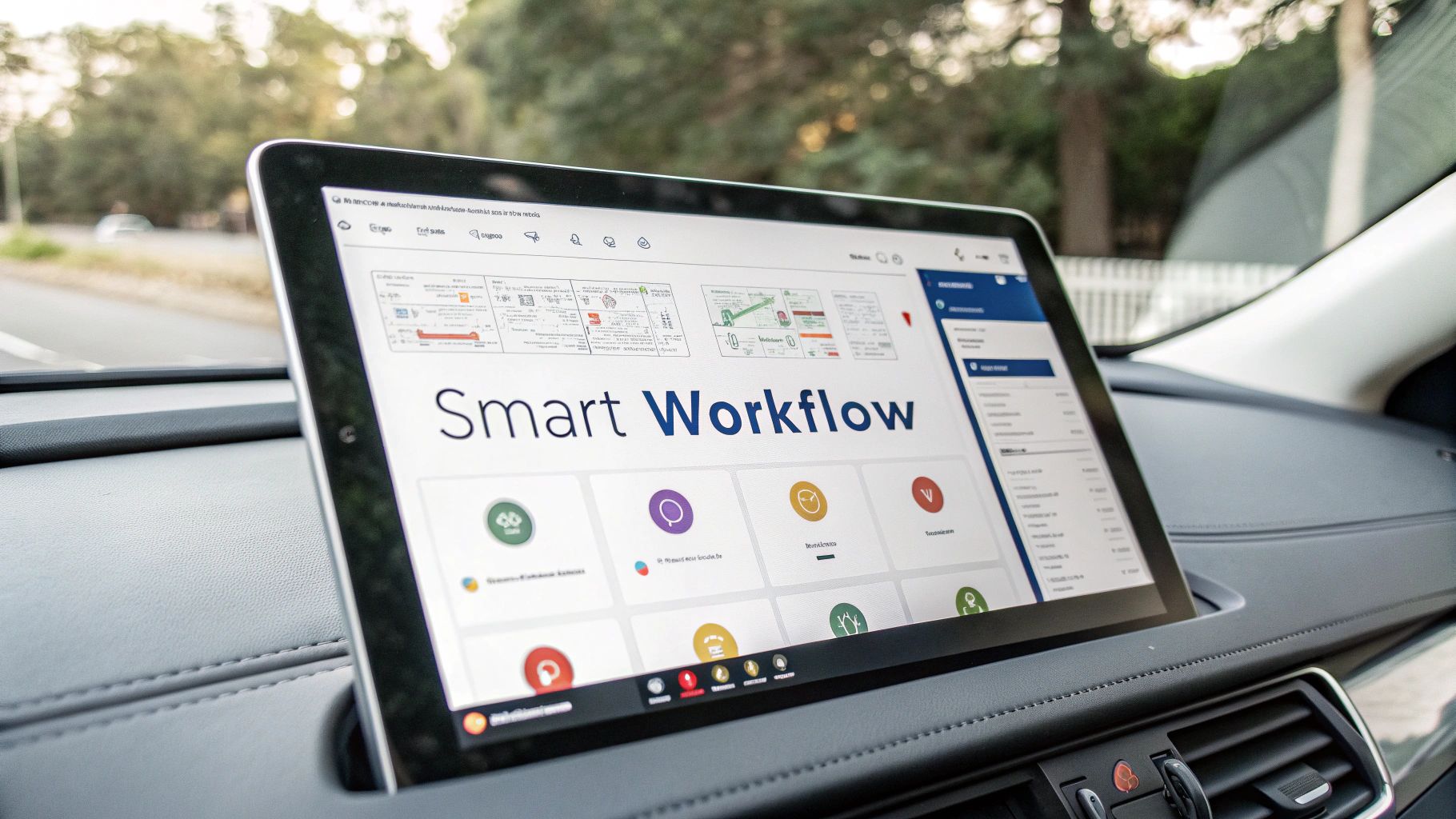The Real-World Impact of Working Asynchronously

Asynchronous work has become a significant operational shift for many modern organizations. It's no longer just a passing trend, but a core strategy impacting how teams communicate, collaborate, and achieve their goals. This new approach offers significant benefits, particularly for remote and hybrid teams, by promoting flexibility and productivity.
One of the key changes with asynchronous work is how teams manage their time. Instead of everyone needing to be online at the same time, individuals can contribute when they're most productive. This is especially helpful for global teams spanning different time zones. Time differences become an advantage, enabling continuous progress around the clock.
For example, a team member in London can finish a task, and a colleague in San Francisco can pick it up seamlessly. This ensures consistent project momentum without interruption.
Communication and Documentation
This shift in work style also significantly impacts communication. Asynchronous communication relies heavily on tools like Slack that facilitate detailed documentation and clear updates. This reduces the need for constant real-time meetings and promotes more focused, individual work. This documentation creates a valuable knowledge base accessible to all team members, regardless of location or time zone.
This shared understanding keeps everyone informed and aligned, even without constant synchronous interaction. It encourages more thoughtful communication and well-considered decisions, reducing the pressure of immediate responses often found in synchronous environments.
Productivity and Accountability
Asynchronous work also changes how businesses view productivity and accountability. The emphasis shifts to deliverables and outcomes, rather than hours spent online. This results-oriented approach empowers employees to manage their time effectively. Studies show that remote workers can save between 2 to 3.5 hours daily by avoiding commutes and unnecessary meetings.
Furthermore, research indicates that employees working asynchronously can be just as productive, with 79% reporting little to no impact on their performance. Find more detailed statistics here. This focus on outputs fosters a more accountable and efficient work culture.
The Future of Asynchronous Work
The increasing reliance on tools and technologies to support asynchronous work creates exciting opportunities for future advancements. These digital platforms will continue to evolve, further optimizing remote collaboration. Asynchronous work isn't a temporary fad, but a significant evolution in how we work, reshaping the professional landscape. It empowers teams to be more productive, flexible, and ultimately, more successful.
Unlocking the Hidden Benefits of Working Asynchronously

Asynchronous work offers much more than flexible hours. It provides a range of advantages that can significantly impact a company's profits and employee well-being. This approach changes how teams function, creating chances for deeper focus, wider talent acquisition, and a more inclusive environment. This means businesses can use async work to improve efficiency and build a more engaged and happy workforce. Learn more in our article about How to Master Asynchronous Collaboration.
Deep Work and Productivity
One of the biggest benefits of asynchronous work is the ability to cultivate deep work. By reducing interruptions from meetings and instant messages, async work lets people dedicate uninterrupted blocks of time to challenging tasks. This focus leads to better quality work and increased productivity.
Imagine a software developer working on a tough coding problem. In a synchronous environment, their concentration could be broken by meetings or urgent requests. But, in an asynchronous setting, they can set aside several hours to focus solely on coding. This dedicated time can lead to faster problem-solving and quicker development.
Access to Global Talent
Asynchronous work also unlocks a global talent pool. Companies are no longer restricted by location when hiring. This access lets organizations find the best talent, no matter where they live.
Finding skilled professionals worldwide not only strengthens teams but also brings in diverse viewpoints and experiences. This diversity encourages innovation and creativity within the company.
Inclusivity and Flexibility
Async work promotes inclusivity by accommodating various work styles and personal situations. It allows team members to organize their day around their most productive hours and personal needs. This flexibility is particularly helpful for people with caregiving responsibilities or those who work best outside the typical 9-to-5 workday.
This freedom lets employees manage their time efficiently, creating a healthier work-life balance and enhancing overall well-being.
To further illustrate the differences between synchronous and asynchronous work, let's look at a comparison table:
Synchronous vs. Asynchronous Work Comparison
A detailed comparison of traditional synchronous work models against modern asynchronous approaches across key factors
| Factor | Synchronous Work | Asynchronous Work | Business Impact |
|---|---|---|---|
| Communication | Real-time meetings, instant messaging | Email, project management tools, documentation | Increased flexibility, potential for miscommunication |
| Collaboration | In-person or virtual meetings | Shared documents, online workspaces | Enhanced collaboration across time zones, requires clear processes |
| Decision-Making | Immediate responses, quick decisions | Considered responses, strategic decisions | Reduced impulsive decisions, potentially slower decision-making process |
| Work Schedule | Fixed hours, in-office presence | Flexible hours, remote work options | Increased work-life balance, potential for burnout if not managed well |
| Talent Pool | Limited by location | Global access to talent | Wider access to skilled professionals, increased diversity |
This table highlights key differences and similarities between the two work models, showing how asynchronous work can offer significant advantages in areas like talent acquisition and work-life balance, while also requiring careful management of communication and decision-making processes.
Tangible Business Outcomes
The advantages of asynchronous work lead to measurable business results. Many companies report lower costs because of reduced overhead from physical office spaces. Plus, thoughtful implementation of asynchronous practices has boosted productivity. Improved employee satisfaction and lower turnover are other common benefits. These positive changes show how async work can reshape how we work and improve a company's performance.
Thoughtful Decision-Making
Finally, asynchronous work encourages more careful decision-making. Instead of quickly reacting to requests, people have time to think about information and create well-considered responses. This leads to more strategic thinking and fewer rushed decisions. This deliberate approach contributes to better results and a more proactive work environment.
Navigating Common Challenges When Working Asynchronously

Asynchronous work offers many benefits, but it also has its challenges. Successfully adopting this work style requires addressing these obstacles directly through open communication and adapting workflows. Let's explore some common hurdles and practical solutions for teams working asynchronously.
Communication Gaps and Misinterpretations
One of the biggest challenges is clear communication. Without real-time interaction, it's easy for messages to be misinterpreted. This can cause confusion, delays, and mistakes. However, establishing strong communication protocols can minimize these risks.
For instance, clear guidelines about which communication channels to use can make a big difference. Using email for formal announcements and Slack for quick questions helps maintain clarity. Encouraging team members to over-communicate and document decisions also helps prevent misunderstandings.
Maintaining Team Cohesion
Building team unity is another hurdle. When team members work across different locations and time zones, developing strong relationships can be tough. This lack of connection can impact morale and collaboration. Regular virtual social interactions and team-building activities are key.
These can include virtual coffee breaks or online team games. These casual interactions build camaraderie and create a stronger sense of belonging.
Overcoming Isolation
A potential downside of asynchronous work is the risk of isolation. While this work model is successful for many individuals and organizations, feeling disconnected from colleagues can be a real concern. A survey showed that 83% of employers consider the shift to remote work a success for their company. Explore this topic further. Asynchronous communication needs good documentation and management tools, like Asana, to maintain seamless collaboration across time zones. Proactive strategies are needed to ensure everyone feels connected and supported.
Regular check-ins, both individually and as a team, can help identify and address feelings of isolation. Creating virtual spaces for casual conversation and social interaction can also foster a sense of community.
Establishing Effective Feedback Loops
Providing timely feedback in asynchronous environments presents a challenge. Without regular face-to-face interaction, it's harder to provide constructive criticism and ensure everyone is aligned. This is why establishing clear feedback mechanisms is critical.
Using tools and processes for sharing feedback, such as regular project updates and peer reviews, can bridge the gap. Encouraging a culture of open communication ensures everyone receives the support they need to thrive while working asynchronously. This includes clear guidelines for giving and receiving feedback constructively.
Essential Tools That Transform Working Asynchronously

Switching to asynchronous work isn't just about changing how you think. It's about having the right tools to make communication and collaboration smooth. Picking the right tools can significantly impact your team's success. This means choosing tools designed for the specific needs of asynchronous workflows, not just general-purpose tools. For more insights on this topic, check out this helpful resource: How to Master Asynchronous Collaboration with the Right Tools.
Project Management Platforms: Enhancing Visibility
Good project management is important for every team. But it's especially vital for teams working asynchronously. Visibility into projects is key. Teams need to clearly see who's working on what, when deadlines are, and how the project is progressing overall. This keeps everyone on the same page, even without constant real-time check-ins.
- Asana: Offers comprehensive task management, project timelines, and progress tracking.
- Trello: Uses a Kanban-style board to visually represent workflows and task statuses.
- Monday.com: Provides customizable dashboards and automation to streamline project management.
These platforms help teams assign tasks clearly, manage deadlines, and track progress, which makes everyone more accountable and boosts efficiency.
Documentation Systems: Preventing Knowledge Silos
Avoiding information silos is critical for successful asynchronous work. It’s important to have one central place for documents, decisions, and project updates. This ensures that everyone can access the same information, which reduces confusion and duplicated work.
- Notion: Combines note-taking, project management, and wiki functionality into one platform.
- Confluence: Offers powerful documentation capabilities, with features like version control and collaborative editing.
- Google Workspace: Provides a suite of tools, including Docs, Sheets, and Slides, making it easy to create and share documents.
These tools help teams share knowledge and improve transparency – essential ingredients for teams spread across different time zones and schedules.
Communication Channels: Respecting Time Zones
Asynchronous communication needs to respect everyone's time and focus. This means choosing tools that allow for delayed responses and minimize interruptions, so team members can focus on important work without distractions.
- Slack: Offers threaded conversations and channel-specific notifications to minimize distractions.
- Microsoft Teams: Combines chat, video conferencing, and file sharing for both synchronous and asynchronous communication.
- Email: Is still valuable for formal announcements and detailed updates.
These tools allow clear and organized communication while respecting individual schedules, creating a more focused work environment.
Coordination Solutions: Eliminating Friction
Coordination tools help streamline workflows and eliminate friction in asynchronous teams. These tools automate routine tasks and provide real-time project updates.
- Zapier: Automates tasks across different apps, reducing manual work.
- IFTTT: Creates automated workflows, triggering actions based on certain events.
The following table showcases a breakdown of these tools by category, highlighting their key features and suitability for different team sizes:
Top Asynchronous Work Tools By Category
| Category | Top Tools | Best Features | Ideal Team Size |
|---|---|---|---|
| Project Management | Asana, Trello, Monday.com | Task management, progress tracking, customizable dashboards | Small to Large |
| Documentation | Notion, Confluence, Google Workspace | Note-taking, wiki functionality, version control, collaborative editing | Small to Large |
| Communication | Slack, Microsoft Teams, Email | Threaded conversations, channel-specific notifications, file sharing | Small to Large |
| Coordination | Zapier, IFTTT | Task automation, workflow triggers | Small to Large |
This table highlights the diverse range of tools available to support asynchronous work, offering options for teams of all sizes and needs.
By using these tools effectively and establishing clear communication guidelines, teams can overcome the typical challenges of asynchronous work and realize its full potential. This empowers people to work productively and effectively, ultimately achieving shared goals.
Building a Thriving Asynchronous Work Culture
The difference between struggling and thriving in an asynchronous work environment often comes down to a consciously built culture. Simply having the right tools isn't enough. Organizations need to create an environment that genuinely supports this way of working. This means setting clear expectations, building trust, and maintaining connections within distributed teams. Let's explore some practical ways to build a thriving asynchronous work culture.
Establishing Norms and Expectations
A solid foundation starts with well-defined norms and expectations. This includes clear communication guidelines that outline the preferred channels for different types of messages. For instance, urgent issues might require a direct message, while routine project updates are best suited for a dedicated project channel. This clarity minimizes confusion and promotes efficient communication.
In addition, establish clear expectations for response times. In asynchronous work, immediate responses aren't the standard. Instead, set reasonable timeframes for acknowledging and handling requests. This respects everyone's focused work time and reduces the pressure of constant availability. For more tips, check out this helpful resource: Remote Team Work Guide.
Fostering Trust Through Results
Trust is essential for any distributed team. Results-based evaluation becomes even more important than tracking hours worked. Concentrate on deliverables and outcomes, empowering team members to manage their own time effectively. This autonomy builds a sense of ownership and accountability, ultimately strengthening the team’s performance.
The right project management software can greatly enhance productivity in an asynchronous setting. This Project Management Software Comparison offers a comprehensive look at various tools.
Communication Guidelines That Protect Focus
Communication protocols should protect deep work. Encourage team members to schedule dedicated focus blocks and clearly communicate their availability. This reduces interruptions and allows everyone to dedicate uninterrupted time to complex tasks, ultimately increasing productivity and ensuring everyone can contribute their best work.
Meaningful Connection Points
While minimizing synchronous meetings is important, maintaining team cohesion is crucial. Intentional connection points are key. These might include regular virtual coffee breaks, online team-building activities, or dedicated social channels. These interactions build camaraderie and a sense of belonging, reducing the potential for isolation in distributed teams.
Practical Approaches to Onboarding, Recognition, and Collaboration
Successful asynchronous work cultures also have strong strategies for onboarding, recognition, and collaboration.
-
Onboarding: Provide new team members with comprehensive documentation and resources. This ensures they understand the asynchronous workflow from day one. Pairing new hires with a mentor can also help them navigate the initial stages of remote work.
-
Recognition: Publicly acknowledge achievements and contributions to foster a sense of value and appreciation within the team. This can be done through dedicated communication channels, team meetings, or virtual celebrations.
-
Collaboration: Establish clear processes for collaborative work, utilizing shared documents, online whiteboards, and project management tools. This facilitates smooth workflows and avoids information silos.
By implementing these strategies, organizations can cultivate thriving asynchronous work cultures that support distributed teams, empower individual contributors, and unlock the true potential of this flexible work style.
The Evolving Landscape of Working Asynchronously
Working asynchronously isn't a fixed concept. It's constantly changing, shaped by new technologies and evolving work preferences. To understand where asynchronous work is going, we need to explore the emerging trends influencing the future of distributed teams.
The Rise of AI Assistants in Async Collaboration
Artificial intelligence (AI) is rapidly changing how we work, and its influence on asynchronous collaboration is especially significant. AI assistants can automate routine tasks, such as scheduling meetings across different time zones. They can also summarize long email chains and even draft initial versions of documents. This allows team members to concentrate on more strategic, creative work. Imagine an AI assistant compiling key discussion points from different communication channels into a concise summary, saving time and improving decision-making.
Virtual and Augmented Reality for Connection and Collaboration
Virtual Reality (VR) and Augmented Reality (AR) technologies offer new possibilities for connection and collaboration in asynchronous teams. VR environments can provide immersive spaces for team meetings, brainstorming sessions, and even casual social interaction. This helps bridge the distance between team members. AR can overlay digital information onto the real world, boosting productivity in various industries. Imagine a design team working on a 3D model in a shared VR space, no matter where they are physically located.
Project Management Innovations Solving Coordination Challenges
Traditional project management tools sometimes struggle to meet the unique needs of asynchronous work. However, new project management innovations are tackling long-standing coordination problems. These tools offer advanced features like automated workflows, real-time progress tracking, and intelligent task assignment. This helps distributed teams stay organized and efficient. For example, a project management tool using AI can predict potential roadblocks and recommend proactive solutions, preventing delays and keeping projects on track.
Adapting to the Changing Talent Marketplace
Demographic shifts and changing worker expectations are driving asynchronous work adoption across industries that were previously hesitant. Forward-thinking companies are adapting to these changes by investing in technologies that support distributed teams. They're also creating flexible work policies and building cultures that prioritize results over being physically present in an office. These companies are positioning themselves to attract and retain top talent in a competitive market. This access to a global talent pool gives companies a significant advantage.
This move towards remote and hybrid work models is fueled by increasing demand for flexible work arrangements. By 2025, 22% of the American workforce is expected to work remotely, with 53% in a hybrid model. 68% of employees prefer a hybrid work environment, demonstrating the strong desire for flexibility that asynchronous models can offer. This hybrid approach allows employees to balance their work and personal lives, leading to greater job satisfaction and productivity. Discover more insights about remote work statistics.
Unlock your team's creative potential with Bulby – the brainstorming tool built for remote collaboration. Start brainstorming with Bulby today.

